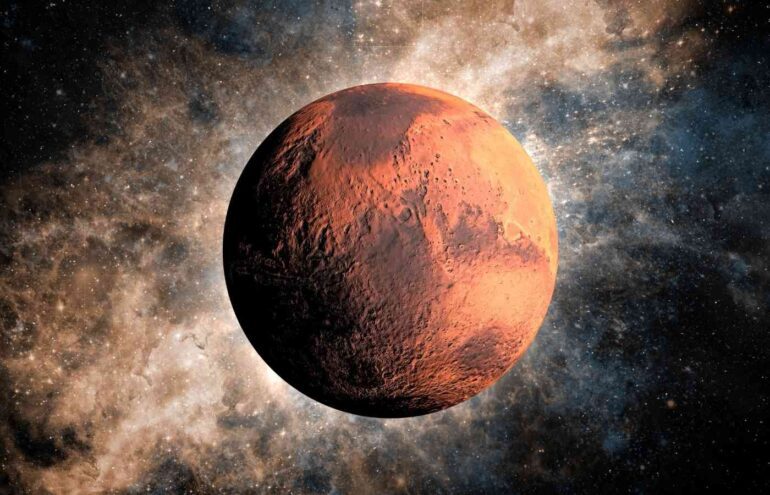TL;DR:
- AI chemist creates oxygen production catalyst from Martian meteorites.
- Scientists aim to generate oxygen on Mars using locally sourced materials.
- Collaboration between USTC and Deep Space Exploration Laboratory.
- AI chemist analyzes Martian ores, performs preparatory steps, and conducts OER testing.
- Machine learning and simulations aid in catalyst development.
- AI chemist produces a stable catalyst, outperforming human capabilities.
- Potential for establishing an oxygen factory on Mars with AI’s assistance.
Main AI News:
As humanity inches closer to realizing the vision of immigration and habitation on Mars, a critical challenge looms – the availability of essential resources like oxygen for long-term survival. However, recent revelations of water activity on the Red Planet have ignited fresh optimism in our quest to overcome these hurdles.
Scientists are now exploring the tantalizing prospect of extracting oxygen from water through electrochemical water oxidation, driven by solar power and aided by oxygen evolution reaction (OER) catalysts. The crux of the matter lies in devising a method to craft these catalysts directly on Mars, eliminating the need for costly transportation from Earth.
Breaking Ground with AI and Martian Chemistry
In a groundbreaking development, a team of scientists led by Prof. Luo Yi, Prof. Jiang Jun, and Prof. Shang Weiwei from the University of Science and Technology of China (USTC), affiliated with the Chinese Academy of Sciences (CAS), has achieved the remarkable feat of autonomously synthesizing and optimizing OER catalysts using Martian meteorites, all thanks to their robotic artificial intelligence (AI) chemist.
This pioneering research, conducted in collaboration with the Deep Space Exploration Laboratory, has recently been unveiled in the prestigious journal Nature Synthesis.
“The AI chemist is a trailblazer in synthesizing OER catalysts from Martian materials through interdisciplinary collaboration,” remarked Prof. Luo Yi, the leading scientist behind this endeavor.
In each experimental iteration, the AI chemist begins by meticulously analyzing the elemental composition of Martian ores, using laser-induced breakdown spectroscopy (LIBS) as its visual apparatus. Subsequently, it proceeds with a sequence of preparatory steps, including precise measurements at the solid-dispensing workstation, formulation of feedstock solutions at the liquid-dispensing workstation, separation of liquids at the centrifugation workstation, and solidification at the dryer workstation.
The resulting metal hydroxides are then treated with Nafion adhesive to fashion the working electrode for OER testing, which is conducted at the electrochemical workstation. Real-time testing data are transmitted to the AI chemist’s computational “brain” for machine learning (ML) analysis.
The “brain” of the AI chemist employs quantum chemistry and molecular dynamics simulations through density functional theory to evaluate the OER catalytic activities of a staggering 30,000 high-entropy hydroxides, each with varying elemental compositions. The simulation data are harnessed to train a neural network model that expeditiously predicts catalyst activities across diverse elemental compositions.
Through Bayesian optimization, the “brain” ultimately determines the combination of available Martian ores necessary to fabricate the optimal OER catalyst.
Achieving a Quantum Leap in Oxygen Production
Thus far, AI chemists have engineered an exceptional catalyst using five distinct types of Martian meteorites under unmanned conditions. This catalyst demonstrates remarkable stability, functioning continuously for over 550,000 seconds at a current density of 10 mA cm-2 and an overpotential of 445.1 mV. A conclusive test conducted at -37 °C, equivalent to Mars’ frigid temperatures, further affirms the catalyst’s ability to consistently generate oxygen without any perceptible degradation.
In a mere two months, the AI chemist has achieved a level of catalyst optimization that would demand 2000 years for a human chemist to replicate.
The team is now diligently working to transform the AI chemist into a versatile experimental platform for diverse chemical syntheses, devoid of human intervention. A respected reviewer of the paper commented, “This research holds immense promise and is rapidly evolving in the realm of organic and inorganic material synthesis and discovery.”
In the not-so-distant future, an oxygen production facility on Mars could become a reality, thanks to the contributions of an AI chemist. A mere 15 hours of solar irradiation would be adequate to generate the requisite oxygen concentration for human sustenance. As Prof. Jiang aptly puts it, “This groundbreaking technology brings us one step closer to realizing our dream of establishing a thriving human presence on Mars.”
Conclusion:
The successful use of AI in synthesizing oxygen production catalysts from Martian materials signifies a major leap forward in the feasibility of human colonization on Mars. This breakthrough technology has the potential to significantly reduce the cost and logistical challenges associated with resource transport from Earth, opening up new opportunities in the emerging market for space exploration and colonization technologies.

